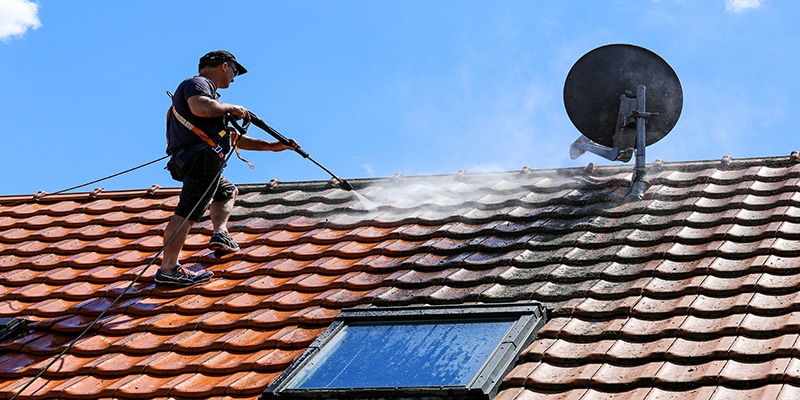When moss and algae are left on a roof, it causes the shingles to deteriorate. This can lead to moisture damage which can cause leaks throughout the home.
There are a number of different products that can be used to clean the roof and kill the spores– bleach solution for hearty moss/algae and spray & forget (water base product) for mildew. Contact Roof Cleaning Sarasota now!

Biological growths such as algae and moss accumulate on roof surfaces, especially in areas with a lot of shade, promoting moisture buildup and eroding shingles. Moss is particularly difficult to remove. Its roots penetrate shingle tiles and cause wood damage, as well as keeping the surface damp for extended periods of time that promote mold and rot. It also keeps the asphalt in shingle roofs moist for too long, and this can lead to premature aging and deterioration.
If you’re considering removing the moss from your roof, try to avoid using chemical solutions that can have unintended downstream impacts on the environment and watersheds. A 50/50 mix of laundry strength liquid chlorine bleach and water may be the best solution, according to the Asphalt Roofing Manufacturers Association (ARMA). Scrub the moss-covered area with a brush or sponge to loosen the root system. Then, rinse the area thoroughly with water to ensure it’s completely free of spores.
A more labor-intensive method involves physically scraping moss off the roof with a hard-bristled brush, and rinsing the surface to remove all traces of it. If you use a manual removal process, be sure to wear rubber gloves and protective clothing and work in small sections. Excessive walking or movement atop the shingles can lift and dislodge granules, damaging the asphalt in the roof.
If you do choose to use a chemical cleaner, opt for one labeled as moss killer or fungicide. It’s best to apply the product on a cloudy day, since it will allow it to soak into the moss for longer, loosening its grip on the shallow roots. Then, rinse the area thoroughly with a hose set to general cleaning or low pressure.
You can also prevent moss from returning by inserting 6-inch strips of zinc or copper under the row of shingles closest to the roof peak. When it rains, metal molecules from the strips will wash down the roof and kill any algae trying to re-establish its hold on the shingles. This is an inexpensive option that can be implemented on an annual basis.
Dirt
Although asphalt shingles have come a long way in recent decades and are less prone to moss growth and those unflattering black streaks, it’s still important to clean your roof regularly. Dirt and grime build up can cause clogged gutters, weakened roofing materials and pest infestations. Regular cleanings will also help extend the lifespan of your roof.
Before applying any chemicals, it’s best to sweep the roof first and remove as much loose debris as possible. This will help prevent slipping and falling, as well as allow the chemical solution to directly target any dirt and grime. It’s important to use a full-body harness and fall arrest equipment when working on the roof, even for professional cleaners.
A pump sprayer or backpack sprayer is a great tool to use for this task, as it allows you to apply the cleaning solution in small sections. Start from the peak of your roof and work your way down, taking care to apply the solution evenly across all areas. You’ll also want to use a noncorrosive cleaning product that won’t harm any nearby plants, trees or bushes.
There are a number of different types of chemical cleaners available, including chlorine bleach which can effectively kill organic matter like moss and algae, as well as more eco-friendly options that don’t contain any harsh chemicals. Be sure to read and follow the instructions for each product carefully before using it.
After the cleaner has had time to break down and dissolve any stuck-on grime, it’s important to thoroughly rinse all areas with plain water. Be sure to take special care when rinsing the edges of your roof and around any planters, as they can be particularly sensitive to high pressure.
Once the cleaning process has been completed, it’s time to prevent future problems by applying a biocide that will inhibit the growth of moss, algae and lichen. This will also ensure that any spores of these organisms hiding in the cracks and crevices of your roof are killed. Once the biocide has been applied, it’s a good idea to repeat this process every few years to keep your roof looking its best and protecting your home or business from harmful weather conditions.
Debris
When you think of cleaning, you probably picture a home or commercial facility where surfaces are mopped, trash is removed, and dusting takes place. But one area that gets less attention than it should is the roof. And yet, a clean roof is essential for protecting the structure from damage and keeping contaminants out of the home or facility.
A lot of debris ends up on the roof, especially if there are a lot of trees surrounding the building. Trees drop twigs, branches, leaves, and other debris on a regular basis. When left unattended, this can build up on the roof and clog gutters or damage the structure of the roof.
Debris can also conceal more serious problems. For example, a large pile of pine needles can block the drainage system and lead to water overflow and interior wall leaks. Leaving such a problem unattended can cost much more in repairs and damage than simply getting rid of the needles.
Besides the obvious, debris can be very dangerous to remove. Getting on top of a roof to remove debris is a hazardous job, even for professionals with the right equipment. A single misplaced step could lead to a fall or worse. Injuries or deaths from rooftop debris can lead to expensive lawsuits and costly repair bills.
Professionals use a variety of tools to safely and effectively clear debris from the roof, including specialized brushes and high-powered blowers. They typically choose a day with clear skies and minimal wind. This mitigates the risk of rain or snow falling in the middle of the job, introducing more hazards with slippery surfaces and covered hazards. Moderate temperatures also keep workers from overheating or numbing their fingers.
Once all the loose debris is removed, a professional may also check the drainage system to make sure it is free of blockages. Then, a hose can be run across the roof to simulate rain and make sure the drains and gutters are working properly. A final step is to rinse away any dirt that was blown off the roof during debris removal.
Chemicals
In order to remove organic growth like algae, moss, mildew and lichen, professional roof cleaners rely on special chemical solutions. These are sprayed on the roofing surface at a pressure not exceeding 100 psi to kill off unwanted growth. Many of these cleaning chemicals are also environmentally friendly. They can be used to clean shingles and other roofing materials, as well as concrete, wood siding, gutters and more. They are a great alternative to power washing which can damage the granules on your roof and void the manufacturer’s warranty.
Most chemical roof cleaning products use a low concentration of chlorine bleach combined with an enhancer, alcohol or surfactants. The chemical solution is then sprayed on the roof and left to kill off the organic growth. Most of these products require a bit of time to do their job, and some labels recommend allowing up to four or five months for the growth to completely die off. During this period, rainwater and gusts of wind will help to wash the dead growth off the roof and surrounding areas.
Some contractors will mix their own homemade formulas by combining high-strength chlorine bleach with an assortment of varied chemicals including phosphates, dish and laundry detergents, assorted surfactants and odor-masking scents. These haphazard chemical concoctions call into question product reliability, stability and safety.
It is important to note that when using any chemical cleaners, you need to take extra care to protect surrounding vegetation and to follow the manufacturer’s instructions for use and safety precautions. While chemical cleaning is safer and more effective than mechanical washing, it is still necessary to properly prepare and rinse the area.
Professional soft washing contractors are able to provide detailed instructions for use and can recommend the best chemical cleaners for your specific roof. They can also provide bulk supplies of the chemicals needed to maintain a steady supply for regular soft washing. For example, they can provide sodium percarbonate, an oxygen-based chemical that does not need to be rinsed off. This is one of the most effective cleaners available for asphalt shingle and wood shake roofs.


